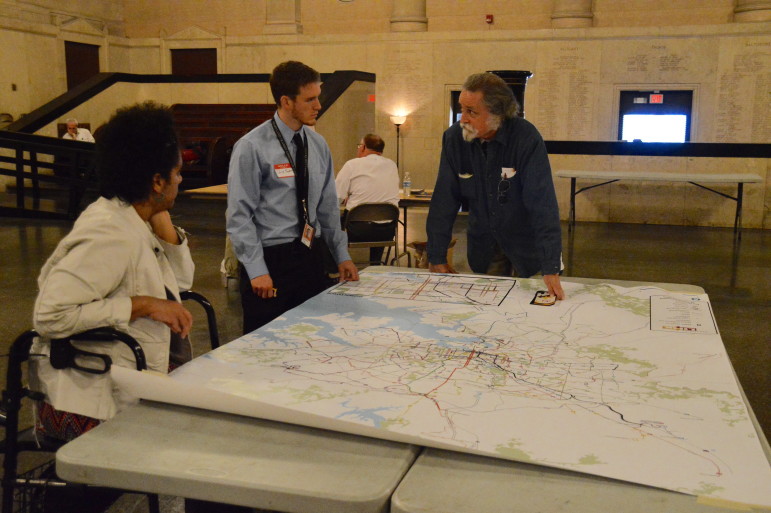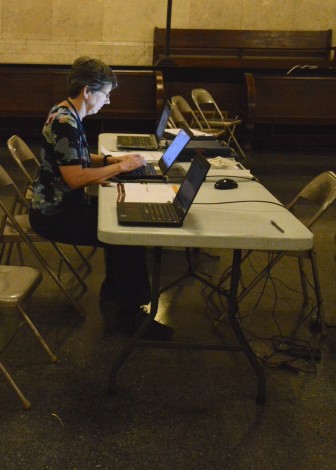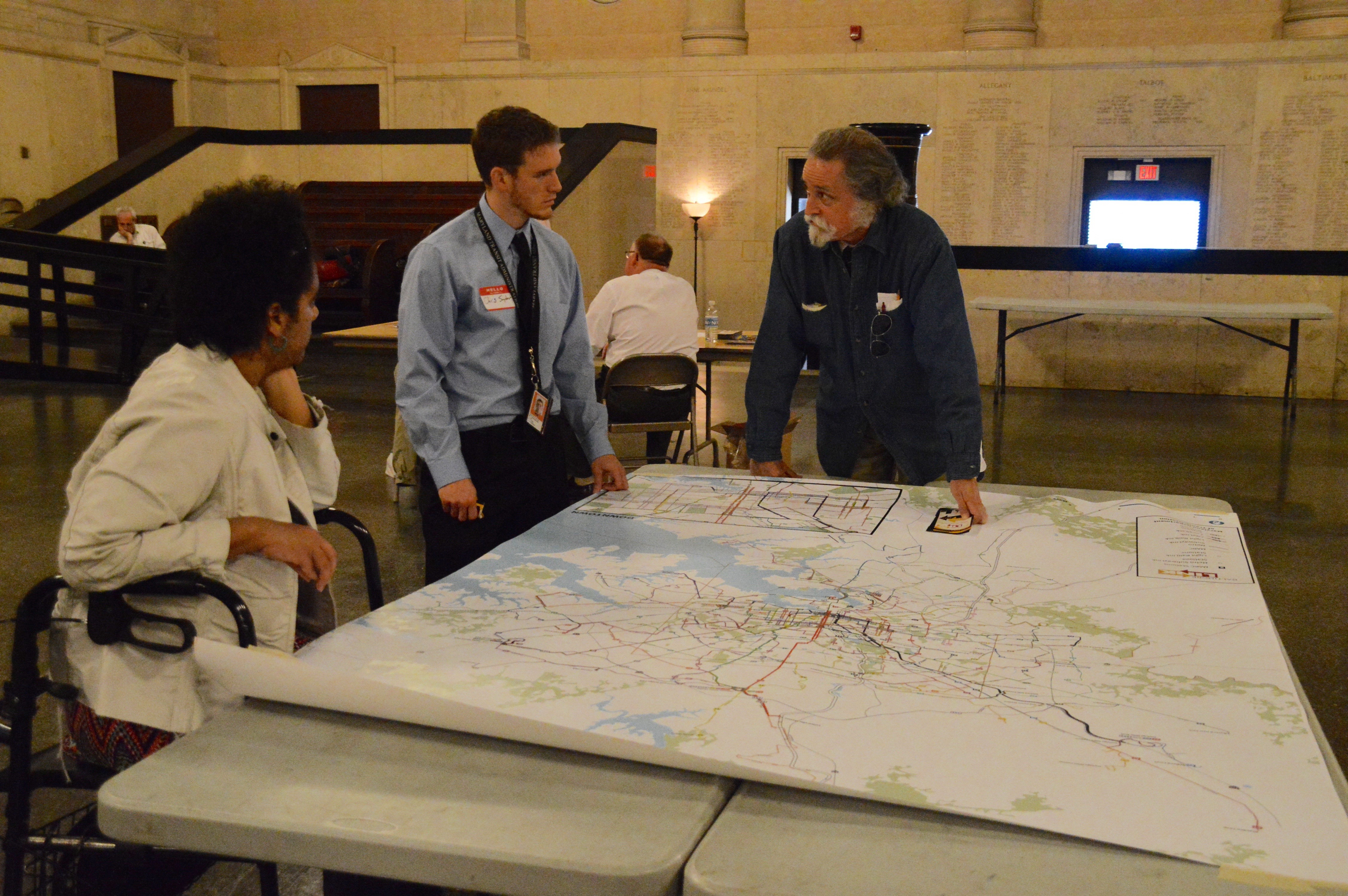By Brittany Britto
Capital News Service

Martin French, far right, talks with Maryland Transit Administration employee Chris Snyder, center, about bus routes at the first BaltimoreLink workshop at Baltimore’s War Memorial on Nov. 4, 2015. French said that the existing bus routes are congested and need to be improved so that people can get to work on time. Capital News Service photo by Brittany Britto
The Maryland Transit Administration on Wednesday hosted the first of several workshops planned throughout Baltimore to discuss details of Gov. Larry Hogan’s new version of the city’s public transit system.
The main floor of the city’s War Memorial was transformed into an open-house style workshop with information boards and maps detailing Hogan’s plans to implement the new $135 million transit system, called BaltimoreLink, set to begin in 2017, according to the Maryland Transit Administration.
BaltimoreLink will connect with other modes of transportation, providing access to 745,000 jobs and creating east-west and north-south bus lanes as well as hubs to connect transit and improve access for riders and bicyclists, according to the Maryland Department of Transportation.
12 express bus routes
Part of the transit plan is CityLink, composed of 12 color-coded and high-capacity bus routes. The buses will run every 10 minutes during rush hour, and every 15 minutes at other times and will connect riders to Amtrak and light rail stations, as well as job centers like Johns Hopkins University and Amazon.
The CityLink system will allow riders to get from one stop to another with no more than one transfer, connecting the city from end-to-end and making commute times 25 minutes shorter, state Sen. Catherine Pugh, D-Baltimore City, said last week. “This is about bridging the gap to where the jobs are.”
Express BusLink, a Baltimore suburban-to-suburban destination system with five new routes, will start in 2016, while CityLink, along with a redesigned LocalLink bus network, will begin in June 2017, according to information from the Maryland Transit Administration.
To further improve the speed of the transit system, buses will be outfitted with sensors, which correspond with similarly outfitted intersections to shorten the wait time at red lights or hold a green light as a bus approaches.
The new transit design efforts are data driven and will expand the transit system by 30 square miles, adding an additional 10 buses, Paul Comfort, administrator for the Maryland Transit Administration, said last week.
Michael Walk, Maryland Transit Administration’s director of service development, gave a presentation around noon Wednesday during the workshop to further explain details about the new transportation plan and opened up a discussion with attendees.
Questions from audience
Many attendees had questions about changes to the bus routes they use most frequently.
Chris Smith, 26, of Baltimore, was disappointed to see that the new service would not include a bus route on Garrison Boulevard.
The bus route currently offers 24-hour service, allowing the Morgan State University student to get to and from downtown after the subway is closed.
Smith, who studies transportation infrastructure, said changing the whole system at once is going to be confusing for residents used to the existing bus system.
“They should change it bit by bit,” Smith said. “They’re planning on flipping the whole system by 2017. Nobody’s going to recognize (anything).”
But Walk asked attendees to not to “throw out the baby with the bathwater,” emphasizing that while they may not like one aspect of the bus system, it does not mean it cannot work for the city as whole.
Walk encouraged attendees to speak with Maryland Transit Administration representatives.
New online comment site

Attendees use laptops to provide feedback and questions about the BaltimoreLink on the Maryland Transit Administration’s newest online comment section, called “My Sidewalk” at the BaltimoreLink workshop on Nov. 4, 2015. Capital News Service photo by Brittany Britto
The transit-system organization also provided attendees with comment cards and laptops to sign in to their newest website addition, “My Sidewalk,” an online comment section for the public to provide feedback, concerns and questions about public transit. Comments will be accepted until Dec. 23.
Anna Ellis of the Hampden neighborhood, a fan of previous plans to implement a Red Line light rail project, which Hogan canceled in June, was one of the first to comment.
The 62-year-old said she takes the bus on occasion, usually when she has a backup plan in case the bus comes earlier or later than expected.
Because the bus system is unreliable, Ellis most often takes Baltimore’s light rail.
“I am skeptical that (the buses) will run as frequently as they are supposed to, because the bus is already supposed to run frequently, and they don’t,” said Ellis, who rides the Route 27 bus, which she describes as “notoriously bad.”
Ellis’ normal bus route has been revamped by the BaltimoreLink plans, and will now require her to make a transfer, meaning she will take two buses to work instead of one.
“This is a boondoggle,” said Ellis. “Canceling the Red Line was a bad idea. We need trains.”
But Maryland Transit Administration employee Chris Snyder said that the BaltimoreLink project has some tradeoffs.
“If the plan is implemented properly, it could be better than the existing one,” Snyder said. “Transforming the whole system for everyone is for the greater common good. The tradeoff is there will be more high frequency lines, which may mean more transfers on local lines.”
Crowded buses
Martin French, who has been commuting by bus for over 30 years, said the crowding on Baltimore buses is one of the biggest current problems that could be alleviated by hiring more operators and purchasing more buses.
“One unfortunate thing is that the buses during rush hour are often too full and have to leave people. I feel bad for those folks. To have people go past them is a real problem,” French said. “Improving reliability is key to increasing ridership, and when I mean reliability, I mean being there.”
Wayne Morse, Maryland Transit Administration’s deputy director of customer and community relations, said extensive research and work have been done in order to plan the project.
“The BaltimoreLink has elements of other plans put together previously,” Morse said, including the Bus Network Improvement Plan, an initiative to improve the bus systems throughout the state. “The Maryland Transit Administration is always striving to improve transportation.”
Nine workshops planned
The Maryland Transit Administration is scheduled to host nine workshops before the end of the year, and stated in a release earlier this week that each workshop will present the same information.
The Maryland Transit Administration is planning to host a mobile pop-up workshop Nov. 5, 8:30-10:30 a.m. at Lexington Market on an MTA bus, giving bus commuters and passersby the chance to view new bus routes and plans.
“I’m hoping for the best, but if they actually pull this off, I will be shocked,” Ellis said.
CNS Correspondent Naomi Eide contributed to this report.




I’m finally getting 110 Dollars p/h,..,{.It’s time to take some action and you can join it too.It is simple,dedicated and easy way to get rich.Three weeks from now you will wish you have started today….
==–=>>> See web Address in my ???????….
626
I have made $ 8569 this month.I’m finally getting 97 Dollars p/h,….It’s time to take some action and you can join it too.It is simple,dedicated and easy way to get rich.Three weeks from now you will wish you have started today….
===>>> Visit Website in my ???????
30
I want to show you something bigger for easy life with extra income every month. I’m finally getting 97 Dollars p/h,….It’s time to take some action and you can join it too.It is simple,dedicated and easy way to get rich.Three weeks from now you will wish you have started today….
===>>> See website listed in my ???????
146
Where are the 745,000 jobs ? I wonder where that figure came from, given the fact that Maryland has lost both jobs and residents during the “wonderful” O’Malley administration…
As for crowded buses during rush hours… That happens everywhere…
And the Red Line wouldn’t be the same way ?
I rode DC’s Metro for years and their railcars were PACKED during rush hours, even with extra cars…
And running mostly empty buses after 11pm doesn’t make sense fiscally…
Public mass transit is very limited and inconvenient ( try taking home 2 weeks worth of groceries home via bus ) which is why people own cars…Also, cars aren’t limited by schedules…
Public transit is no panacea and not everybody will get everything they want…
I have made $ 7854 pe r m0nth. I’m finally getting 97 Dollars p/h,….It’s time to take some action and you can join it too.It is simple,dedicated and easy way to get rich.Three weeks from now you will wish you have started today….
===>>> See web Address in my Profile
141